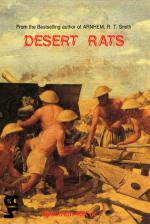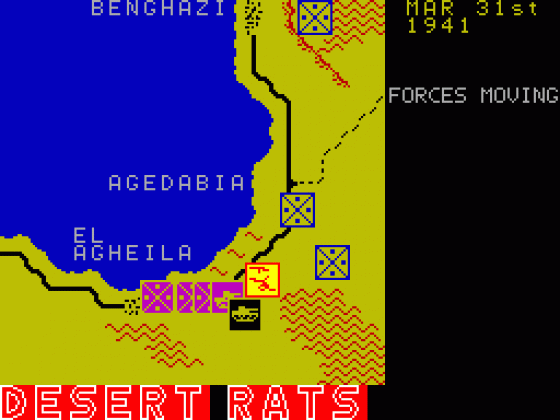
Sinclair User
 14th January 1986
14th January 1986
Categories: Review: Software
Author: Chris Bourne
Publisher: Cases Computer Simulations
Machine: Spectrum 48K/128K
Published in Sinclair User #48
Desert Rats
THE DESERT WAR of 1941-1942 ought to be ideal computer wargame fodder. For a start, there were plenty of opportunities for both sides to mess it up, so that while the original outcome was, as in most wars, more or less inevitable, life is by no means so secure for the player.
Secondly, the deserts of North Africa are easy to represent on the TV screen. Lots of yellow, some areas of hills, thick red lines for cliffs and a black road running along the coast just about sums it up. The playing area stretches from El Agheila to Alexandria - about half of Libya and most of Egypt - which puts the game on the campaign level, as opposed to Bob Smith's earlier game, Arnhem, which is a more tactical affair.
Thirdly, the war in the desert remains one of the more popularly romantic episodes in a brutal period of conflict. It was the first major British victory, it was accomplished without the aid of American troops, and it involved two highly colourful antagonists - General Montgomery and the archetypal 'good' German, Erwin Rommel.

It was also the first wargame I ever played - Avalon Hill's Afrika Korps, a classic boardgame from the sixties. Nostalgic memories may bias me in favour of the scenario, but there's no doubt that the CCS simulation is quite superb, in many respects better than Arnhem, and streets ahead of anything else in the field.
The game begins with the ancient ritual of running through the options. You have a choice of one or two-player games, and six scenarios. Those include Rommel's initial campaign which bottled up the Allies in Tobruk; an introductory scenario based around the first British attempt to relieve Tobruk; Operation Crusader - the major British offensive to relieve Tobruk; Gazala - Rommel's push east of Tobruk which forced the Allies back to the lines of El Alamein; and El Alamein itself, where Montgomery decisively defeated Rommel. You can play each scenario in turn, or choose a grand game encompassing the whole war in a gigantic free-for-all.
The Desert War was a largely mechanised affair, and tanks play a crucial role. There are three types of tank unit - medium tanks, light tanks, and slow infantry support tanks. There are also recce units, motorised infantry, ordinary infantry, support groups, anti-tanks units and artillery. Some units are HQs and those are important in maintaining supply lines. On top of that, each unit can dig-in or even fortify its position.
When you come to move a unit, you can obtain a report on its strength, morale, and efficiency. Information is also given on its state of supply and particular ability at attacking.
There's a whole range of possible actions. Movement is carried out by shifting the cursor to the appropriate goal and pressing ENTER. Assault is similar but involves more aggression while Hold is an instruction to dig-in. Divide allows you to break grouped units into smaller divisions. Fortify strengthens a dug-in position and Travel enables you to move swiftly down a road if it's unblocked.
A special command. Go To Port, transfers troops between Alexandria and Tobruk, but only if both cities are occupied by a British unit.
Combat occurs when units are next to each other, and you get sound effects which can become pretty demoralising when the opposition lets off a sustained burst of screeching and all your units manage in reply is a muted belch. But although it's vitally important to ensure the correct right type of units are leading your attack, the game is ultimately won or lost depending on how you organise your supplies.
There are two types of unit - ordinary units and HQs. Supplies are handled very simply. Ordinary units must be next to their divisional HQ or any Corps HQ to draw supplies Any HQ must be within seven 'squares' - there's no formal grid on the screen but it's easy to judge - of a road to supply itself, but only if the road is clear of enemy units ail the way back to your edge of the map.
If a unit is left without supplies it will start to deteriorate and eventually become useless. This is a simple and logical system which works well in the game, and forces players to centre the fighting around key points on the road, Tobruk being the most important. Reconnaissance units are particularly useful for cutting supply lines, and if you can succeed in sandwiching your opponent his entire army may collapse with heartening speed.
The graphics are simple and pleasant. Enemy units are not identified until they actually fight, and although life gets confusing if you stack or overlap a whole bundle of units together, that is no more than you should expect - good generalship is partly a matter of knowing which units are where and making sure they arrive at their destination in good order.
The El Alamein scenario is particularly confusing, with two enormous armies bunched together across a minefield. Before you complain, consider that Monty spent nearly six weeks training his troops in the precise tactics to be used - he even produced a traffic control system to organise a smooth flow of forces through the small gaps made in German lines. You can't expect to emulate that five minutes after reading the rules, and I managed to hand Rommel the whole of Egypt on a plate the first time I tried.
The map scrolls across two-thirds of the screen - the total area is about three and a half screens, which is ample for all scenarios except El Alamein. All the orders are contained in the right-hand screen third, and brief details of units are given in the bottom two lines, including occasional reports.
Historical accuracy is tempted by the inclusion of three 'skill' options. In reality the Allies used Malta as a base from which to destroy Axis supplies. If you want to play 'what if?' scenarios, you can choose to ignore Malta altogether, or allow the German Operation Herkules in 1942 to be successful, in which case you lose Malta at that point and Rommel receives extra supplies late in the game.
The system has the virtue of allowing you to make moves far ahead of a single turn. For instance, if you want to shift a unit all the way down the road - say, five turns worth of travel - you could move the cursor to the destination and then the unit will simply follow the original order for each move unless you change it.
That allows you to set long-term objectives and then adjust only those orders which become irrelevant - just as a real general would. The computer responds extremely swiftly, and although it sometimes plays a little passively, does not do anything obviously stupid which might break the illusion of authenticity.
Furthermore, the full campaign - which I recommend wholeheartedly, having spent a whole day playing it much to the disgust of old Scolding - provides plenty of authentic touches. Those include the withdrawal of the Australian units, after the war against Japan gets underway, and 'reorganisation phases' when there was little activity in North Africa because of events eleswhere. Those give you the opportunity to take a breather and build up reinforcements and new positions. They tend to push you towards re-fighting the actual battles of the war instead of the crazy all-out slaughter which some computer wargames allow.
Most important of all, it's easy to get into the game. The booklet of rules seems dauntingly long, but that is due to long explanations of the various commands and hints on how to use units effectively.
Half the booklet is taken up with an account of the various historical battles, so even if you're not possessed of a detailed knowledge of military history you can still follow the original tactics if you want.
Desert Rats is an example of what computer wargames should be about, and sets a new and impressive standard for others to follow. Bob Smith says it took him longer to write than the excellent Arnhem - we hope he has something even more spectacular on the drawing-board. In the meantime, get dug in with the Eighth Army and prepare for action - you won't want to pull your head out of the sand for many weeks.
Chris Bourne
Publisher: CCS Programmer: Bob Smith Price:: £9.95 Memory: 48K
*****
Other Reviews Of Desert Rats For The Spectrum 48K/128K
Desert Rats (Cases)
A review by Sean Masterson (Crash)
Desert Rats (Cases)
A review by Sean Masterson (Crash)
Desert Rats (Cases)
A review
Desert Rats (Cases)
A review
Desert Rats (Cases Computer Simulations)
A review












